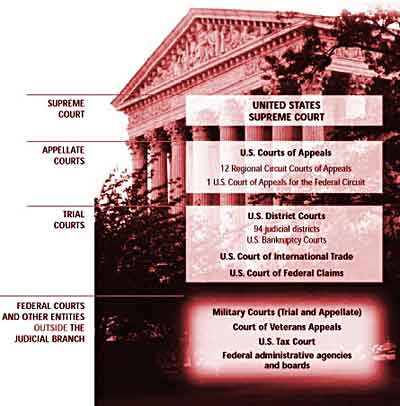The principle of stare decisis asserts that courts "must follow earlier judicial decisions when the same points arise again in litigation." Black's Law Dictionary 1537 (9th ed. 2009). Generally, the lower courts (trial courts) bind the parties involved but no other trial courts and no higher courts. Appellate courts follow their own precedence (through the principle of horizontal stare decisis) and lower courts within their jurisdiction but do not bind other appellate courts at the same or a higher level.
Many, but not all, jurisdictions call their court of last resort the Supreme Court. It is always a good idea to research your jurisdiction's court system in order to see the hierarchy.
At the top of the court hierarchy is the Ohio Supreme Court which has a Chief Justice and six Justices. It has original jurisdiction in select cases. It is the court of law resort on state constitutional questions and questions of public or great general interest. It accepts appeals from the Board of Tax Appeals, Public Utilities Commission and death penalty cases. The Court of Appeals is the next level of court. There are twelve appellate districts and decisions are made by three-judge panels unless reviewing a case en banc. The Court of Appeals provides appellate review of the judgments of the common pleas, municipal, and county courts. It also hears appeals from the Board of Tax Appeals, and has original jurisdiction in select cases. Below the Court of Appeals are the Courts of Common Pleas, which are in each of the 88 counties. The Courts of Common Pleas are divided into a General Division, which covers civil and criminal cases and appeals from most administrative agencies; Domestic Relations Division, which covers divorces and dissolutions, and child support and child custody; Juvenile Division, which covers offenses involving minors and most paternity actions; and the Probate Division, which covers decedent's estates, mental competency, adoptions, and marriage licenses. In parallel with the Courts of Common Pleas, are the Municipal and County Courts. They cover misdemeanor offenses, traffic cases, and civil cases up to $15,000. Also in parallel is the Court of Claims. Judges for the Court of Claims are appointed by the Chief Justice. They hear suits against the state for personal injury, property damage, contracts, wrongful deaths, and appeals from decisions made by the attorney general on claims allowed under the Victims of Crime Act. Mayor’s courts are not a part of the judicial branch of Ohio government and are not courts of record but a person convicted in a mayor’s court may appeal the conviction to the municipal or county court. The Mayor's Courts hear violations of local ordinances and traffic laws.
In the hierarchy of case law authority, state and federal courts are parallel systems. Usually the state hierarchy includes a State Supreme Court as the court of law resort. It is parallel to the U.S. Supreme Court. Below the State Supreme Court is the Court of Appeals which is parallel to the United States Courts of Appeal in the federal system. Finally, the lowest level of court would be the trial courts which parallel the United States District Courts in the federal system.

The federal court system consists of the United States Supreme Court at the top of the court hiearchy. Below the U.S. Supreme Court are the United States Courts of Appeals. There are 12 regional Circuit Courts of Appeals and the Court of Appeals for the Federal Circuit. Below the U.S. Courts of Appeals you have the U.S. District Courts. These are the trial courts. There are 94 judicial districts. At this level there are also the U.S. Bankruptcy Courts, the U.S. Court of International Trade, and the U.S. Court of Federal Claims. Congress also created several Article I, or legislative courts. These include the military courts, Court of Veterans Appeals, and the U.S. Tax Court, Not included in the judicial branch but having quasi-judicial functions are agencies and boards.
.
University of Cincinnati Libraries
PO Box 210033 Cincinnati, Ohio 45221-0033
Phone: 513-556-1424
University of Cincinnati
Alerts | Clery and HEOA Notice | Notice of Non-Discrimination | eAccessibility Concern | Privacy Statement | Copyright Information
© 2021 University of Cincinnati
